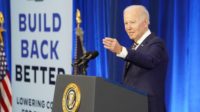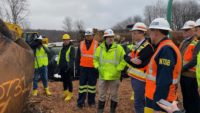Steel interests have misgivings about the fairness of a California law, enacted last month, intended to minimize carbon footprints of certain construction materials used in state-funded building projects by requiring all products to have a global warming potential less than the industry average. The Buy Clean California Act will require a successful bidder to submit an environmental product declaration—a product’s climate-change profile—for “eligible materials.”
Carbon-steel rebar, flat glass, mineral-wool board insulation and structural steel are listed. Concrete and wood are not.
“Our concerns are that the bill does not address all construction materials equally by not including the same requirements for concrete and wood [as it does for steel],” said John Cross, vice president of special projects for the American Institute of Steel Construction (AISC), at the 2017 Greenbuild International Conference and Expo, held on Nov. 8-10 in Boston.
By Jan. 1, 2019, the state Dept. of General Services must establish a “maximum acceptable global-warming potential” for each material category. For this, DGS will set the potential using the “industry average of facility-specific global warming potential emissions for the material,” states the act.
By Jan. 1, 2022, and every three years after, DGS will review the global-warming potential for each eligible material.
Beyond the question of fairness, AISC would like assurance that DGS’s methodology for its selections is based on “a sound technical foundation,” said Cross. “Developing the rules is going to be a real challenge,” he adds, noting that there are several questions that need attention.
One question is whether the process of establishing the global-warming potential is focused at the mill step or the fabricator step of the supply chain. Another is how DGS will take into account the impact of uncertainty in determining global-warming effects, said Cross.
AISC is also concerned about the identification of each product category’s rules to ensure environmental product declarations are comparable. Further, the group wants DGS to address the treatment of end-of-life credits.
AISC “would welcome the opportunity” to discuss its misgivings with the DGS technical team, said Cross. “We want to make sure the rules are developed in an equitable manner,” he said.
On the materials front, the team for the permitted Framework project—a 148-ft-tall, mass-timber multi-use building designed for a Portland, Ore., site— announced it is delaying construction, originally expected to begin earlier this year, until early next year. The new goal is to complete the project, which received its construction permit in May, by mid-2019—at least a year later than planned.
“As with many public-private projects, there are often delays due to the multiple agencies and procedures involved,” said the Framework team in a statement.
On Nov. 7, the Portland Housing Bureau’s Fast Starts program awarded the owners, Framework Project LLC and Home Forward, $6 million to develop 60 units of affordable housing.
On the subject of reducing carbon emissions by creating buildings that produce as much energy as they use in a year, Chris F. Chatto, a principal at ZGF Architects, said the ZGF-designed, 15,600-sq-ft Innovation Center of the Rocky Mountain Institute, built to be net-zero energy (NZE), is producing 20% more electricity than it uses, after nearly two years of occupancy.
The $8-million project—sited in Basalt, Colo., in the second-coldest region in the U.S.—demonstrates that NZE is possible in all climates, though strategies will differ depending on the locale, said Chatto. “If we can do it in Colorado, it is possible” to do it in less-extreme climates, even without central heating or cooling, said Chatto.
To get to NZE, ZGF included natural ventilation, an insulated envelope, window shading and thermal mass. There is no cooling system. Instead of a central boiler, there is occupant-controlled electric-resistance heating under the carpets.
On the topic of water conservation, the developers of the “Non-Potable Water Reuse Practice Guide” issued a 60-page online “teaser,” available for free download, in advance of the release of a longer version early next year.







Post a comment to this article
Report Abusive Comment